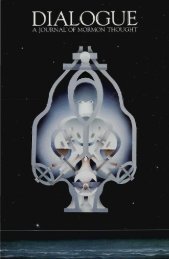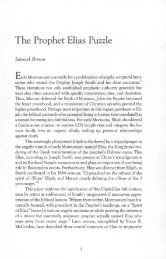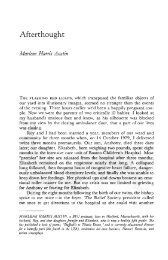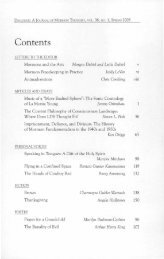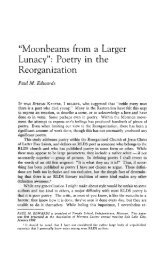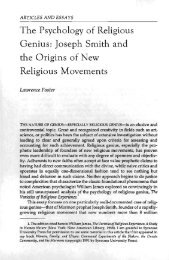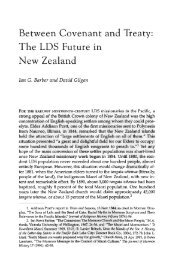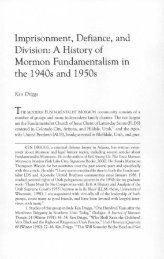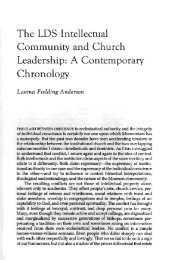Dialogue, Volume 25, Number 2 - Dialogue – A Journal of Mormon ...
Dialogue, Volume 25, Number 2 - Dialogue – A Journal of Mormon ...
Dialogue, Volume 25, Number 2 - Dialogue – A Journal of Mormon ...
Create successful ePaper yourself
Turn your PDF publications into a flip-book with our unique Google optimized e-Paper software.
124 DIALOGUE: A JOURNAL OF MORMON THOUGHT<br />
would say things like, "The Church promotes ignorance and mediocrity<br />
in culture and art"; "The gospel admonition to not be <strong>of</strong> the world<br />
is fulfilled by the members shunning secular learning"; "The Church<br />
has accepted the gospel <strong>of</strong> the American dream and exalts the<br />
commonplace"; or "LDS bookstores are filled with poorly written prose<br />
by Church authorities and the spiritual wet dreams <strong>of</strong> writers <strong>of</strong> popular<br />
<strong>Mormon</strong> fiction."<br />
I usually defended the Church, saying we should be hopeful and<br />
give other members the benefit <strong>of</strong> the doubt, if for no other reason<br />
than because being too critical <strong>of</strong> fellow saints seemed wrong. Ken<br />
insisted that this attitude only fostered their mediocrity. At times I<br />
would think to myself, "Ken is on the road to apostasy; don't let him<br />
drag you down too! Just forget it. You know how he talks. He gets so<br />
angry, he couldn't have the right spirit about him." On the other hand,<br />
I wanted to deal with this conflict. I wanted to know the truth. After<br />
talking to Ken, I would struggle all day with what he had said —trying<br />
to refute his arguments, trying to understand what he had said, trying<br />
to find out what was right.<br />
Sundays were not the same. Everything I heard and saw at church<br />
now seemed shallow. I wanted people to tell the truth, not sugar-coat<br />
reality. Even the cover <strong>of</strong> my priesthood manual irritated me. The<br />
illustration <strong>of</strong> the young, biblical Daniel turning down the meat and<br />
wine <strong>of</strong>fered by the king by holding up his hand in a halting motion<br />
reduced the simple honesty <strong>of</strong> Daniel's example to a trite, sentimental<br />
message.<br />
I began wondering: If this is the Lord's church, why don't we want<br />
to tell the truth? Why does the <strong>of</strong>ficial Church foster art without conflict,<br />
when conflict is an integral part <strong>of</strong> our growth toward salvation?<br />
Why do we act like the key to salvation is merely to ignore anything<br />
evil or unpleasant, when evil is all around us, and inside us, and is the<br />
opposition against which we work out our salvation? Is the truth simply<br />
that the world's standards are evil, even when it comes to good art?<br />
Can an artist please the world and God at the same time, or does the<br />
very nature <strong>of</strong> telestial life prevent that? Why do we feel that artists<br />
who acknowledge doubt, immorality, and sin are risking their salvation?<br />
While reading an interview with Hugh Nibley, I found mention <strong>of</strong><br />
a BYU master <strong>of</strong> fine arts thesis written by Lori Schlinker entitled<br />
Kitsch in the Visual Arts and Advertisements <strong>of</strong> the Church <strong>of</strong> Jesus Christ <strong>of</strong><br />
Latter-day Saints (1971). "Kitsch" a German word, describes art that is<br />
<strong>of</strong> low quality, unoriginal, and sentimental. The thesis focused on the<br />
way <strong>Mormon</strong>s and other Christians debase Christ and his mission<br />
through cheap artistic representations. I began to realize that kitsch is<br />
not just an LDS phenomenon, but a universal problem.



